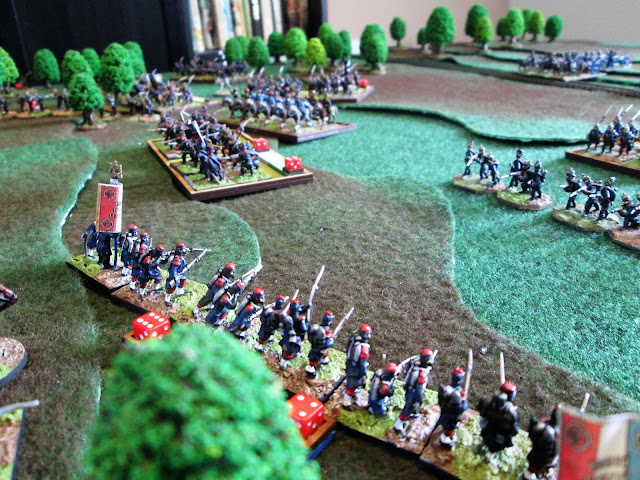The Prussian 88th regiment deciding to exploit the weakness of the centre left of the French line was ordered to charge forwards using cold steel, but cold steel means nothing when facing both the French chassport and, for this game at least another double six!
Five casualties and again killing the Prussian officer on the serendipity table faltered the Prussian division during the charge. I, as umpire and player of both sides decided that the 88th would go in against the French regardless of the falter (nobody argued against me!).
With a good roll for the Prussians and a mediocre one for the French, the 88th prevailed forcing the French regiment to retreat.
However the remaining French regiment to the right of the gap, even with ten casualties inflicted upon it managed in the firing segment to knock off the one remaining casualty left to the 88th thereby eliminating it completely. The air was thick with lead.
Above, the end of turn 6.
The French left still looked in severe danger in danger of collapse and so it proved, a desultory roll on the Falter table proved to be the end for the French left flank division a withdraw result saw it leave the table having had enough. The Prussians continue to push through the woods while the French reserve cavalry move to their left to try to fill the gap.
Turn 7.
As in history, sometimes, as in wargames, the only immediate force at hand to plug the gap in the left centre was a French curiassier division from the reserve so McMahon turned and ordered it forward.
Charging downhill the French heavies carried all before it forcing the Prussians to retreat. The curiassiers occupied the position right in the face of a Prussian regiment.
Note: At this point I decided to use the charge procedure for cavalry from the General de Armee ruleset rather than Picket's Charge in the future as I think this encompasses European methods rather than the civil war ones better.
You could have predicted what was going to happen, during the movement phase the Prussians surrounded the exposed French cavalry and simply blew it away inflicting ten casualties on a small unit removing it from the game. You would have got a different result if the Gen de Armee cavalry sequence had been used.
More proof of the power of the chassepot on troops in the open, though this Prussian regiment had suffered some casualties previously as soon as it exited from the village it was destroyed by French fire, rolling a nine on the fire table and three additional CD dice casualties. Unit destroyed, division falter, though it has to be said that this Prussian division had Hesitant marker on it for the past three turns!
Schmidt on the Prussian left finally gets moving, I suspect he saw what was going on to his right!
View from the Prussian centre.
Finally, the Prussian right continuing it's progress through the woods.
Laters guys.
Dave.




















































